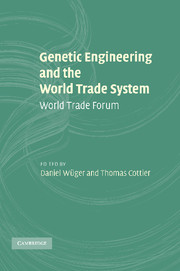Book contents
- Frontmatter
- Contents
- List of contributors
- List of abbreviations
- PART I Introduction and systemic issues
- PART II Intellectual property and gene technology: issues at stake and possible options
- 4 Biotechnology and patents: global standards, European approaches and national accents
- 5 Intellectual property rights, biotechnology and development: African perspectives
- 6 Traditional knowledge, biogenetic resources, genetic engineering and intellectual property rights
- PART III Food security, trade and agricultural production with genetically modified organisms
- PART IV Food safety, international trade and biotechnology
- PART V Medical research, cloning and international trade
- Index
4 - Biotechnology and patents: global standards, European approaches and national accents
Published online by Cambridge University Press: 06 October 2009
- Frontmatter
- Contents
- List of contributors
- List of abbreviations
- PART I Introduction and systemic issues
- PART II Intellectual property and gene technology: issues at stake and possible options
- 4 Biotechnology and patents: global standards, European approaches and national accents
- 5 Intellectual property rights, biotechnology and development: African perspectives
- 6 Traditional knowledge, biogenetic resources, genetic engineering and intellectual property rights
- PART III Food security, trade and agricultural production with genetically modified organisms
- PART IV Food safety, international trade and biotechnology
- PART V Medical research, cloning and international trade
- Index
Summary
Introduction
Intellectual property rights have, from their inception, been shaped by international treaties. National legislators have had to look at the international scene to gain some insight into the prevailing intellectual property standards. This trend was less prominent in the field of patent law, and it was only with the coming into effect of the Agreement on Trade-Related Aspects of International Property Rights (TRIPS Agreement) that key international standards with regard to patents were established. In that regard, TRIPS seemed to constitute einen Meilenstein von enormer Bedeutung (a major milestone), since, for the first time in patent history, it introduced a worldwide framework of minimum standards with regard to the grant, scope and use of patent rights.
The present paper describes the global standards for the patenting of biotechnological inventions and offers an in-depth and critical comparison with those of European and national regimes. Section B describes the TRIPS rules for the patenting of biotechnological inventions and centres on six key issues: plants and animals, the human body, ethics, human rights, traditional knowledge and health. Section C examines the European patent biotech framework and revolves around the same topics. This examination demonstrates clearly that European patent law has adapted itself to the new reality of biotechnology in many ways, but that various issues remain unsettled and so call for further reflection and debate. In section C, a number of national patent systems for biotechnological inventions are considered, focusing on the same six topics.
- Type
- Chapter
- Information
- Genetic Engineering and the World Trade SystemWorld Trade Forum, pp. 77 - 108Publisher: Cambridge University PressPrint publication year: 2008
- 6
- Cited by



